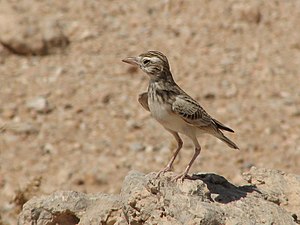False aversion
| False aversion | ||||||||||||
|---|---|---|---|---|---|---|---|---|---|---|---|---|

False aversion |
||||||||||||
| Systematics | ||||||||||||
|
||||||||||||
| Scientific name | ||||||||||||
| Spizocorys starki | ||||||||||||
| ( Shelley , 1902) |
The falconry ( Spizocorys starki ) is a small species of the lark family with a finch-like beak and a small feather hood. Their distribution area is the south of Africa. No subspecies are distinguished.
In 2016, the IUCN's Red List of Threatened Species listed the fallow larch population as “ Least Concern (LC) ” = “not endangered”.
The species is occasionally placed in the genus Eremalauda , but genetic studies have confirmed the relationship with the other species in the genus Spizocorys .
features
The Falblerche reaches a body length of about 14 centimeters, of which between 4.3 and 4.8 centimeters are on the tail. The beak measures between 1.32 and 1.45 centimeters from the skull. They weigh between 15.5 and 22.5 grams. There is no gender dimorphism .
Fallowers are very lightly feathered larks. They are yellow-brown on the crown, neck, back neck, coat and back. The darker feather centers create a striped appearance. The crown feathers are comparatively long and erectable, so that the lark, unlike other representatives of the genus, has a small feather hood. The upper tail-coverts are yellow-brown with a hint of pink. The sides of the neck and the front neck are yellow-brown. The over-eye stripe and the dark circles are whitish.
The chin and throat are whitish, the front breast, on the other hand, pale brownish with dark brown dashes. The underbust turns whitish. The belly and the underside of the tail are also whitish. The hand and arm wings are brown and lined with yellow-brown. The tail feathers are predominantly brown, the sixth (outermost) control feather has a white outer vane and a white-brown inner vane, the fifth control feather is only white on the outer vane. The middle pair of control feathers is light brown with yellow-brown edges and yellow-brown tips.
The beak is conical, whitish to horn-colored and has a darker tip. The iris is brown.
singing
The male sings both from the ground and from low shrubbery, but also shows the singing flight typical of larks. When singing, the male usually rises 50 to 200 meters above the ground and circles there singing and flying against the wind for a few minutes. Then it suddenly drops back down to the ground. There are also singing flights low above the ground, with the male flapping and letting his feet hang down, while otherwise, when flying, the feet are drawn towards the chest so that they disappear into the plumage and the back of the legs points to the ground.
Possible confusion
The Falblerche is very similar to the red-billed , finch and blackbird , all of which also belong to the genus Spizocorys . The Falblerche differs from these species by its white underside and small hood. The Red Schnabellerche also has a redder beak, the Ammernlerche has a more striking facial pattern.
Distribution area and habitat
The distribution area of the Falblerche extends from southwestern Angola in a southerly direction via Namibia and the southwest of Botswana to the South African Republic.
The habitat of the falconry are stony semi-deserts and gravelly areas with sparse grass cover. The Falblerche is one of the larks found in the Namib, but is water-dependent. If the natural water holes dry out, it leaves the Namib Desert. Outside the breeding season, there are occasional flocks that can include thousands of individuals.
Way of life
The falconry eats seeds, insects and green plant material. According to a study of populations in the central Namib , seeds cover 77 percent while insects account for 19 percent. The rest of the food is covered with vegetable food.
The Fallowche is an opportunistic breeding bird whose breeding season begins after the rains. Therefore, the breeding season usually falls between March and May, around four to eight weeks after the end of the rainy season.
Like all larks, the Falblerche is a ground breeder. The clutch consists of two to three eggs. Unlike many species of lark, both parent birds breed. The breeding season is about 11 days. The nestlings are fed by both parent birds. They leave the nest when they are around 10 days old, but are not yet able to fly at this point.
literature
- Rudolf Pätzold : The larks of the world. Westarp Sciences, Magdeburg 1994, ISBN 3-89432-422-8 .
- Rudolf Pätzold: Compendium of Larks. All the larks on earth. Jan-Schimkat-Medienpublikation, Dresden 2003, ISBN 3-00-011219-7 .
Web links
Single receipts
- ↑ a b c Pätzold: Compendium of Larks. P. 288.
- ↑ Spizocorys starki in the endangered Red List species the IUCN 2016 Posted by: BirdLife International, 2016. Retrieved on 9 October 2017th
- ↑ a b c Handbook of the Birds of the World zur Falblerche , accessed on March 11, 2017.
- ↑ a b c Pätzold: Compendium of Larks. P. 287.
